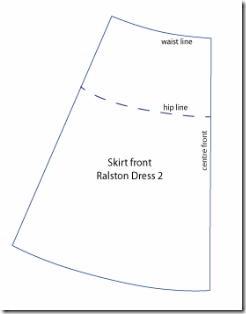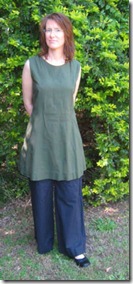Drafting the pattern for Dress 2 and two garments based on this design.
Step one: taking measurements
Ralston uses imperial measurements. If you are used to metric measurements you may wish to convert them. I have never used imperial measurements before but found them very easy to work with using a tape measure and ruler with metric on one side and imperial on the other. Sticking with imperial measurements works very well for the calculations needed. Because you are frequently dividing by two and four, 1/2, 1/4 and 1/8 inch units are actually very convenient and can be calculated quickly by folding your tape measure.
Ralston gives clear comprehensive instructions for taking measurements. The only tricky part was the width of chest and back (highlighted in the illustration below):
All the other measurements correspond to easily defined anatomical points. Chest and back width, however, are design choices determined by how much you would like your armhole to curve in at front and back. I initially drafted these measurements far too wide and, after making the first toile, cut away 1 1/2 - 2 inches from the front and back.
Step two: drafting the pattern
By following Ralston’s instructions I drafted a bodice front pattern like this:
The back looks much the same except there is no pleat in the shoulder.
The skirt is made by drawing two rectangles of the same width as the waist line on the bodice front and back, cutting them into four equal sections (stopping just short of the waist line) and spreading these sections until the hip line is the required measurement. The resulting draft looked like this:
In keeping with the fashion of the time the design is loose in the bust and close-fitting in the hip. Ralston’s instructions provide for a total ease of two inches in the bust but no ease in the waist or hip. I added ease to both waist and hip of about three inches. I think modern fitted garments would normally have one inch ease at the waist and three at the hip. I initially cut the skirt to mid-calf length.
Step three: cutting and sewing
Ralston doesn’t give any cutting or sewing instructions. So the rest was up to me. I used dark green cotton from my fabric stash. I lined the bodice and added a zip in the centre back. I haven’t lined a bodice in years and found sewing smooth curves on my new (to me) Brother PS-57 sewing machine quite challenging. I really miss my old 1960s Bernina which I found easier to control.
Then I tried on the resulting loose-fitting dark green dress . Though certainly comfortable, it was horrible! The dress went straight past modest, and took a sharp right at dowdy. Visually, it suggested a deep disdain for the flesh. It looked as though it might conceal a hair shirt and sandpaper underpants. In retrospect the dress might have developed a different personality if I had used a brightly coloured print in a softer fabric that draped better.
I was unwilling to trash my fabric and this much effort. So I cut the dress to tunic length and made a pair of loose black trousers to go with it. Here is a quick snap of the (unironed) result:
It looks a little better with heels but the lawn was too squishy. Overall I found the result is wearable though not my favourite. I will add a slippery lining to the skirt so that it doesn’t “grab” at the trousers.
I went on to adapt Ralston’s pattern one more time with better results. More about that in my next post.





No comments:
Post a Comment